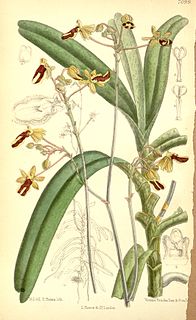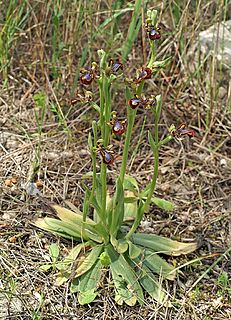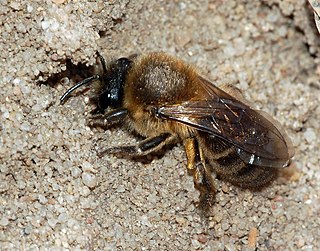
Fig wasps are wasps of the superfamily Chalcidoidea which spend their larval stage inside figs. Most are pollinators but others simply feed off the plant. The non-pollinators belong to several groups within the superfamily Chalcidoidea, while the pollinators are in the family Agaonidae. While pollinating fig wasps are gall-makers, the remaining types either make their own galls or usurp the galls of other fig wasps; reports of them being parasitoids are considered dubious.

Ophrys apifera, known in Europe as the bee orchid, is a perennial herbaceous plant of the family Orchidaceae. It serves as an example of sexually deceptive pollination and floral mimicry, as well as of a highly selective and highly evolved plant–pollinator relationship.

The genus Ophrys is a large group of orchids from the alliance Orchis in the subtribe Orchidinae. They are widespread across much of Europe, North Africa, Caucasus, the Canary Islands, and the Middle East as far east as Turkmenistan.

Ophrys lutea, the yellow bee-orchid, is a species of orchid native to southern Europe, North Africa, and the Middle East, the range extending from Portugal and Morocco to Syria.

Ficus citrifolia, also known as the shortleaf fig, giant bearded fig, Jagüey, wild banyantree and Wimba tree, is a species of banyan native to southern Florida, the Caribbean, Mexico, Central America, and northern South America south to Paraguay. It is distinguished from the closely related Florida strangler fig mainly by the finer veining in the leaves.

Microtis, commonly known as onion orchids or mignonette orchids is a genus of about 20 species of plants in the orchid family, Orchidaceae. Onion orchids are terrestrial herbs with a single leaf at the base of the plant. They are similar to orchids in the genus Prasophyllum in that they have an onion-like leaf. The flowers are small but often scented and attractive to their insect pollinators. They are widespread in Asia, Australia and some Pacific islands.

Ophrys insectifera, the fly orchid, is a species of orchid and the type species of the genus Ophrys. It is remarkable as an example of sexually-deceptive pollination and floral mimicry as well as of a highly-selective and highly evolved plant-pollinator relationship.

Nectar is a sugar-rich liquid produced by plants in glands called nectaries or nectarines, either within the flowers with which it attracts pollinating animals, or by extrafloral nectaries, which provide a nutrient source to animal mutualists, which in turn provide herbivore protection. Common nectar-consuming pollinators include mosquitoes, hoverflies, wasps, bees, butterflies and moths, hummingbirds, honeyeaters and bats. Nectar plays a crucial role in the foraging economics and evolution of nectar-eating species; for example, nectar foraging behavior is largely responsible for the divergent evolution of the African honey bee, A. m. scutellata and the western honey bee.

Ophrys bombyliflora, the bumblebee orchid, is a species of Ophrys, native from the Mediterranean region from Portugal and the Canary Islands to Turkey and Lebanon. The genus name Ophrys is from the Greek in reference to the hairy lips of the flowers of this genus; the specific epithet bombyliflora is from the Greek bombylios (bumblebee) in reference to the appearance of the flowers of this species.

Ophrys sphegodes, commonly known as the early spider-orchid, is a species of sexually-deceptive orchid native to Europe and the Middle East. It is a very varied species with many subspecies recognised.
The Giardino delle Orchidee Spontanee del Mediterraneo is a botanical garden operated by the World Wide Fund for Nature within its Palo Laziale nature reserve. It is located Via Palo Laziale 2, Palo Laziale, Ladispoli, Province of Rome, Lazio, Italy.

Ophrys fusca, commonly known as the sombre bee-orchid or the dark bee-orchid, is a species of orchid native to the Mediterranean from southwestern Europe and northern Africa to western Asia. Most subspecies of the Ophrys fusca are pollinated by males of Andrena bees.

Ophrys tenthredinifera, the sawfly orchid, is a terrestrial species of orchid native to the Mediterranean region from Portugal and Morocco to Turkey. The common name refers to a purported resemblance between the flower and the sawfly, a wasp-like insect.

Cottonia is a monotypic genus of flowering plants from the orchid family, Orchidaceae: the only known species is Cottonia peduncularis. It is native to India and Sri Lanka. The genus was erected by Robert Wight and named after Major Frederick Cotton, an amateur botanist who served in the Madras Engineer Group and collected the species from Tellichery. A coloured illustration of the plant had been sent to Wight by Thomas C. Jerdon.

Spiculaea is a genus of plants defined by a single species, Spiculaea ciliata, commonly known as elbow orchid, and allied to the family Orchidaceae. Endemic to the south-west of Western Australia, they are unusual in a number of respects; it grows in shallow soil on granite rock outcrops, grows and flowers in the hottest months of the year and has a unique method of using thynnid wasps as pollinators.

In evolutionary biology, mimicry in plants is where a plant organism evolves to resemble another organism physically or chemically, increasing the mimic's Darwinian fitness. Mimicry in plants has been studied far less than mimicry in animals, with fewer documented cases and peer-reviewed studies. However, it may provide protection against herbivory, or may deceptively encourage mutualists, like pollinators, to provide a service without offering a reward in return.

Ophrys speculum, the mirror orchid, is a species of Ophrys distributed throughout the Mediterranean that is pollinated exclusively by a single species of scoliid wasp.

Argogorytes mystaceus is a species of solitary wasp in the family Crabronidae.

Eucera longicornis is a species of bee in the family Apidae, subfamily Apinae, and tribe Eucerini, the long-horned bees.

Colletes cunicularius, the vernal colletes or spring mining bee, is a species of solitary bee from the family Colletidae which is widespread in the Palearctic from Britain to the Pacific Ocean which nests in areas of open, sandy soil.



















